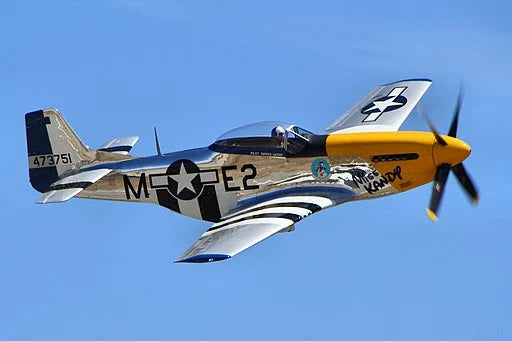The P-51 Mustang is one of World War II’s most iconic fighter aircraft, known for its speed, range, and maneuverability. Produced by North American Aviation, the Mustang was a game-changer for the Allies and played a pivotal role in achieving air superiority over Europe.
Origins and Design
The P-51 Mustang emerged out of an urgent requirement early in WWII. North American Aviation developed the fighter in response to British specifications. North American introduced its initial version, P-51A Mustangs, in 1940. Subsequent models saw various modifications through 1944, with P-51Ds becoming the primary production variants.
The Mustang featured a Packard V-1650 Merlin engine, significantly enhancing its performance at higher altitudes. The P-51D featured an improved visibility bubble canopy and six 50-caliber M2 Browning machine guns for weapon protection. Furthermore, its refined fuselage design enabled top speeds of 437mph with external fuel tanks onboard for up to 1,650 miles range.
Role in World War II
The P-51 played an essential part in the European Air War during WWII. With its long range, the Mustang was an ideal escort for U.S. bombers targeting German industrial sites. Furthermore, this aircraft proved formidable against German fighter aircraft as its speed and agility allowed it to hold off more experienced counterparts. Mustang pilots had claimed 4,950 enemy aircraft shot down by the war’s end.
Post-War and Korean War Service
After WWII, the P-51 Mustang continued serving the U.S. Air Force during the Korean War as the F-51. While generally overshadowed by jet aircraft, its close air support and reconnaissance roles proved highly effective.
The Mustang Today
Today, the P-51 Mustang is a prized possession among warbird collectors and a regular participant in air shows worldwide. Its distinctive design and historical significance make it a favorite among aviation enthusiasts.
The P-51 Mustang stands as an icon in aviation history. From its role in helping achieve air dominance during World War II to continuing service during the Korean War, its success can be measured against cutting-edge multirole fighter jets – yet, audiences remain charmed and inspired by this historic fighter aircraft.
What made the P-51 Mustang so special?
The P-51 Mustang is one of the most legendary aircraft from World War II and cannot be overemphasized for its impactful role. Multiple factors contributed to its distinctiveness and effectiveness:
Outstanding Range: The P-51 Mustang was known for its exceptional operational range, especially with external fuel tanks installed. This feature allowed it to escort bombers deep into enemy territory and back – something earlier fighters could not do effectively. This was a game-changer in the air war over Europe, as it drastically reduced the losses of American bombers to enemy fighter aircraft.
High Altitude Performance: Early P-51 Mustang models used the Allison V-1710 engine, which suffered performance issues at higher altitudes. After switching to the Packard V-1650 (license-built version of Rolls-Royce Merlin engine ), however, its capabilities grew dramatically. Being equipped with such an engine allowed it to maintain power and performance at high altitudes, becoming an effective weapon against German fighter aircraft like Messerschmitt Bf 109s and Focke-Wulf Fw 190s.
Maneuverability and Speed: The P-51 Mustang was not only fast – with its top speed estimated to be 437 miles per hour (703 kilometers per hour) – it was also highly maneuverable, giving it the upper hand in dogfights against its enemy counterparts.
Effective Armament: The P-51D Mustang was the most widely produced variant. It was equipped with six M2 Browning machine guns, 50-calibers each. Combined with their speed and agility, these heavy weapons made for an unstoppable force in flight.
Versatility: The Mustang proved to be a highly versatile aircraft. It was primarily a long-range bomber escort in Europe, but it was also effective as a bomber, a ground attack aircraft, and a reconnaissance aircraft. It could carry bombs, rockets, and extra fuel tanks, depending on the mission requirements.
Innovative Design: The P-51 Mustang D model stood out for its innovative design features. One such feature was its bubble canopy, providing pilots better views of their surroundings.
Durability and Maintenance: The Mustang was widely respected for its strength and ease of upkeep, making repairs more manageable under harsh military conditions. This created a crucial contribution.
The P-51 Mustang was one of the greatest fighter aircraft ever created during World War II. It continues to be respected today as one of the most significant aircraft ever constructed.
For more insights into the P-51 Mustang and other important military aircraft, visit Aces In Action. Here, you’ll find an amazing piece of artwork by Craig Tinder titled “Dusk Patrol” that commemorates the pilots of the Eighth Air Force’s 353rd Fighter Group. The limited edition canvas print even includes an actual fragment from a fuselage panel of aircraft Construction No. 122-40530 (N51TH), making it a unique piece of history!
“Dusk Patrol” – P-51D Mustang Aviation Art Print by Artist Craig Tinder
P-51D Mustangs from the Mighty Eighth Air Force’s 352nd Fighter Squadron, 353rd Fighter Group keep a close eye for enemy activity while patrolling over occupied territory. Stationed at RAF Raydon in England, the 353rd Fighter Group flew nearly 450 combat missions including bomber escort missions, and participated in the Battle of Normandy, Operation Market Garden, and the Battle of the Bulge.
To purchase or see similar items, visit here.
Commissioned by Museums, Treasured by Collectors





Share:
Decades of Dominance: The Story of the F-4 Phantom
Silent Defender, the story behind "Doodlebug Ace"